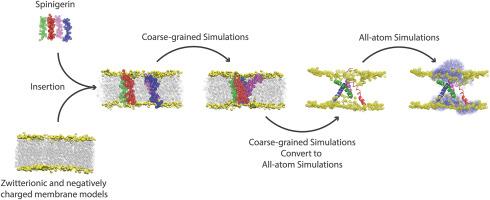Unraveling the mechanisms of spinigerin: A promising antimicrobial peptide against antibiotic resistance through molecular dynamics simulations
IF 3
3区 生物学
Q2 BIOCHEMISTRY & MOLECULAR BIOLOGY
引用次数: 0
Abstract
The rise of infectious diseases driven by antibiotic resistance has become a critical global concern, prompting the search for alternative therapeutic strategies. Among these, antimicrobial peptides (AMPs) have emerged as promising candidates. Spinigerin, a potent AMP, has demonstrated significant antibacterial and antifungal activity. Its mechanism involves disrupting microbial cell membranes by forming transmembrane pores that induce cell lysis. However, the precise mechanisms underlying pore formation remain poorly understood. To explore spinigerin's pore-forming potential, a comprehensive study was conducted using five different membrane models. A combination of coarse-grained (CG) and all-atom (AA) molecular dynamics simulations, along with umbrella sampling, was employed to elucidate the interactions between spinigerin and the membrane models. The results revealed that the peptide induces notable structural changes in the anionic and hybrid membranes, such as increased curvature, lipid reorganization, and altered membrane thickness. In contrast, spinigerin maintains stability in zwitterionic membranes with minimal disruption. Additionally, pore dimension analysis indicated that the initial stage of pore formation was more feasible and stable in the anionic and zwitterionic-anionic membrane models compared to the zwitterionic membrane. These findings underscore the critical role of lipid composition in determining the efficacy and mechanism of action of AMPs like spinigerin. Outstandingly, spinigerin's selective ability to target bacterial membranes while sparing host cells highlights its strong potential as a therapeutic agent.

通过分子动力学模拟揭示菠菜素的机制:一种有前途的抗抗生素耐药性抗菌肽
由抗生素耐药性引起的传染病的增加已成为全球关注的一个关键问题,促使人们寻找替代治疗策略。其中,抗菌肽(AMPs)已成为有希望的候选者。菠菜苷是一种有效的AMP,具有显著的抗菌和抗真菌活性。其机制包括通过形成跨膜孔来破坏微生物细胞膜,从而诱导细胞裂解。然而,人们对孔隙形成的确切机制仍然知之甚少。为了探索spiningin的成孔潜力,我们使用了五种不同的膜模型进行了全面的研究。结合粗粒度(CG)和全原子(AA)分子动力学模拟,以及伞形采样,阐明了spiningin和膜模型之间的相互作用。结果表明,多肽诱导阴离子膜和杂化膜发生明显的结构变化,如曲率增加、脂质重组和膜厚度改变。相反,spiningin在两性离子膜中保持稳定,破坏最小。此外,孔隙尺寸分析表明,与两性离子膜相比,阴离子膜和两性离子-阴离子膜模型在初始阶段的孔隙形成更为可行和稳定。这些发现强调了脂质组成在决定像菠菜素这样的AMPs的疗效和作用机制中的关键作用。值得注意的是,spiningin的选择性能力,以细菌膜为目标,同时保留宿主细胞,突出了其作为治疗剂的强大潜力。
本文章由计算机程序翻译,如有差异,请以英文原文为准。
求助全文
约1分钟内获得全文
求助全文
来源期刊

Archives of biochemistry and biophysics
生物-生化与分子生物学
CiteScore
7.40
自引率
0.00%
发文量
245
审稿时长
26 days
期刊介绍:
Archives of Biochemistry and Biophysics publishes quality original articles and reviews in the developing areas of biochemistry and biophysics.
Research Areas Include:
• Enzyme and protein structure, function, regulation. Folding, turnover, and post-translational processing
• Biological oxidations, free radical reactions, redox signaling, oxygenases, P450 reactions
• Signal transduction, receptors, membrane transport, intracellular signals. Cellular and integrated metabolism.
 求助内容:
求助内容: 应助结果提醒方式:
应助结果提醒方式:


